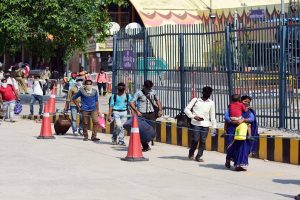INTRODUCTION
The Government of India had decided to consolidate Codes and simplify relating to labour into four from about 30. Following three codes were rationalized into one making it Industrial Relations Code, 2020 ( IR Code):
- The Industrial Disputes Act, 1947 (“ID Act“);
- The Trade Unions Act, 1926; and
- The Industrial Employment (Standing Orders) Act, 1946.
The IR Code was notified on Sept 29, 2020. There are 106 sections in 14 Chapters. A comparison of the past codes with the present OR Code shows that they are substantially the same with two major differences, the threshold of 100 workers for prior permission to retrench etc has been increased to 300 and a fund for re-skilling of retrenched workers have been created from contributions of the employers. It may be recalled that such fund was created by the Central Government with budgetary support after 1991 when a lot of retrenchment took place due to major policy changes.
Highlights of the Act and the main changes Chapter / Section-wise
CHAPTER I: PRELIMINARY Section 1 and 2.
Definitions: A total of 36 definitions are given, mostly adopted from previous Acts. However, some changes have been made. Details of which and other important definitions are as given below:-
- Employers now include who employs in a factory and establishment specifically a manager of a factory, a manager/managing director of an establishment, contractor and legal representative of a deceased employer.
- Fixed-term employment means the engagement of a worker on the basis of a written contract of employment for a fixed period. This is a new term and means a contract employee.
- Industry means any systematic activity carried on by co-operation between an employer and worker for the production, supply or distribution of goods or services with a view to satisfying human wants or wishes. However, it does not include institutions owned by Charitable, social or philanthropic services, domestic services and activity notified by the Government.
- Industrial dispute means any dispute or difference between employers and employers or between employers and workers or between workers and workers which is connected with the employment or non-employment or the terms of employment or with the conditions of labour, of any person and includes any dispute or difference between an individual worker and an employer connected with, or arising out of discharge, dismissal, retrenchment or termination of such worker
- Lock-out means the temporary closing of a place of employment, or the suspension of work, or the refusal by an employer to continue to employ any number of persons employed by him.
- National Industrial Tribunal means a National Industrial Tribunal constituted under section 46
- Negotiating union or negotiating council means the negotiating union or negotiating council referred to in section 14. When there is a single Trade Union, the employer may recognise it as Negotiating Union. In the case of more than one Trade Unions, the Union have 51% or more workers may be recognized. In case no one has 51%, then a Negotiating Council may be formed of Trade Unions having 20% or more worker representation, one seat per 20% representation.
- Registrar means a Registrar of Trade Unions appointed by the State Government under section 5.
- Retrenchment means the termination by the employer of the service of a worker for any reason whatsoever, otherwise than as a punishment inflicted by way of disciplinary action, but does not include retirement / voluntary retirement of a worker, termination of at the end of the contract or due to ill health.
- Standing orders means orders relating to matters set out in the First Schedule; These are certified rules stipulated by the employers for workers regarding worker parameters and their working. The idea is that everything in a factory should happen under a set of rules. The Government will prescribe model rules. If an employer adopts them, he will not separate certification by the stipulated authority.
- Strike means a cessation of work by a body of persons employed in any industry acting in combination, or a concerted refusal, or a refusal, under a common understanding, of any number of persons who are or have been so employed to continue to work or to accept employment and includes the concerted casual leave on a given day by fifty per cent. or more workers employed in an industry. 50% or more CL as the strike is the new addition.
- Trade Union means any combination, whether temporary or permanent, formed primarily for the purpose of regulating the relations between workers and employers or between workers and workers, or between employers and employers, or for imposing restrictive conditions on the conduct of any trade or business. Trade Unions are required to be registered.
- Tribunal means an Industrial Tribunal constituted under section 44. Tribunals may be formed by the State and Central Government for the adjudication of industrial disputes and other functions as specified. It will now consist of two members ( earlier one ) one Judicial, who will preside and one administrative. They are appealable in High Courts.
- Worker means any person (except an apprentice) employed in any industry to do any manual, unskilled, skilled, technical, operational, clerical or supervisory work for hire or reward. Workers now include a working journalist and sales promotion employee. It also includes a supervisory capacity person drawing wages exceeding eighteen thousand rupees per month or an amount as may be notified by the Central Government from time to time. Earlier the amount was Rs ten thousand.
CHAPTER II: BI-PARTITE FORUMS Section 3 and 4
- Work committee: If the number of workers in an industrial establishment exceeds 100, a working committee will be formed between representatives of workers and employer to promote measures for securing and preserving amity and good relations between the employer and workers.
- Grievance Redressal Committees: Every industrial establishment employing twenty or more workers shall have one or more Grievance Redressal Committees for resolution of disputes arising out of individual grievances
CHAPTER III: TRADE UNIONS Sections 5 – 27
- Registrar of Trade Unions: The State Government may, by notification, appoint a person to be the Registrar of Trade Unions and other subordinate officers may also be appointed. Their functions and powers will also be notified.
- Trade Union Registration Criterion: No Trade Union of workers shall be registered unless at least ten per cent. of the workers or one hundred workers, whichever is less.
- Appeal: The decision of the Registrar can be appealed to the Tribunal.
- Immunity: No suit or other legal proceeding shall be maintainable in any civil court against any registered Trade Union or any office-bearer or member thereof in respect of any act done in contemplation or furtherance of an industrial dispute.
- Disputes between Trade Unions/workers: may be referred to the Tribunal.
- Dissolution of a Trade Union: When a registered Trade Union is dissolved, a notice of the dissolution signed by seven members and by the secretary of the Trade Union shall, within fourteen days of the dissolution, be sent to the Registrar, and shall be registered by him if he is satisfied that the dissolution has been effected in accordance with the rules of the Trade Union, and the dissolution shall have effect from the date of such registration.
- Recognition of Trade Unions at Central and State level.: Depending upon the need and merit, Trade Unions may be recognized by notified authorities at central / state levels.
CHAPTER IV: STANDING ORDERS Section 28 – 39
- The provisions of this Chapter shall apply to every industrial establishment wherein three hundred or more than three hundred workers, are employed. Earlier this limit was 100 workers.
- Standing orders means orders relating to matters set out in the First Schedule; These are certified rules stipulated by the employers for workers regarding worker parameters and their working. The idea is that everything in a factory should happen under a set of rules. The Government will prescribe model rules. If an employer adopts them , he will not separate certification by the stipulated authority.
- Appeal against Certifying Officer decisions: may be made to the appellate authority appointed by the appropriate Government, by notification.
CHAPTER V: NOTICE OF CHANGE Section 40 and 41
- Notice for Change in-service conditions of a worker by employer: No employer, who proposes to effect any change in the conditions of service applicable to any worker in respect of any matter specified in the Third Schedule, shall effect such change, (i) without giving to the workers likely to be affected by such change a notice in such manner as may be prescribed of the nature of the change proposed to be effected; or (ii) within twenty-one days of giving such notice.
- Appropriate Government has the power to exempt the service condition change notice.
CHAPTER VI: VOLUNTARY REFERENCE OF DISPUTES TO ARBITRATION Section 42
- Voluntary Reference to Arbitration of an Industrial Dispute: Where any industrial dispute exists or is apprehended and the employer and the workers agree to refer the dispute to arbitration, they may, by a written agreement, refer the dispute to arbitration, and the reference shall be to such person or persons as an arbitrator or arbitrators as may be specified in the arbitration agreement.
- Chance of hearing to other concerned parties: The Government may issue a notification of reference to arbitration. Then the employers and workers who are not parties to the arbitration agreement but are concerned in the dispute shall be given an opportunity of presenting their case before the arbitrator or arbitrators.
CHAPTER VII MECHANISM FOR RESOLUTION OF INDUSTRIAL DISPUTES Section 43 -61
- Conciliation officers: may be appointed by the appropriate Government with the duty of mediating in and promoting the settlement of industrial disputes.
- Industrial Tribunal: may be appointed by the appropriate Government for the adjudication of industrial disputes and for performing other notifies functions.
- It will consist of two members, one judicial and one administrative.
- The Judicial Member shall preside over the Tribunal where the bench of the Tribunal consists of one Judicial Member and one Administrative Member.
- National Industrial Tribunals: The Central Government may, by notification, constitute one or more National Industrial Tribunals for the adjudication of industrial disputes which, in the opinion of the Central Government, involve questions of national importance or are of such a nature that industrial establishments situated in more than one State are likely to be interested in, or affected by, such disputes
- A person shall not be qualified for appointment as the Judicial Member of a National Industrial Tribunal unless he is, or has been, a Judge of a High Court.
- Same Power as Civil Court: The conciliation officer, Tribunal and National Industrial Tribunal shall have the same powers as are vested in a civil court under the Code of Civil Procedure,1908.
- The Tribunal can reinstate a retrenched worker with/without lesser punishment if found proper as the law of the land.
CHAPTER VIII: STRIKES AND LOCK-OUTS Sections 62 -64
- Strike call: No person employed in any industrial establishment shall go on strike, in breach of contract without giving to the employer notice of strike, within sixty days before striking; during Tribunal/reconciliation/arbitrage proceedings and during any period in which a settlement or award is in operation. Earlier the period specified was six weeks.
- A strike will be illegal if is in contraventions to the above provisions ( Section 62 ).
CHAPTER IX: LAY-OFF, RETRENCHMENT AND CLOSURE Section 65 – 76
- Rights of workers laid off for compensation: Whenever a worker (other than a badli worker or a casual worker) whose name is borne on the muster rolls of an industrial establishment and who has completed not less than one year of continuous service under an employer is laid-off, whether continuously or intermittently, he shall be paid by the employer for all days during which he is so laid-off, except for such weekly holidays as may intervene, compensation which shall be equal to fifty per cent. of the total of the basic wages and dearness allowance that would have been payable to him, had he not been so laid-off.
- Conditions precedent to retrenchment of workers: No worker employed in any industry who has been in continuous service for not less than one year under an employer shall be retrenched by that employer until—
- The worker has been given one month’s notice in writing indicating the reasons for retrenchment and the period of notice has expired, or the worker has been paid in lieu of such notice, wages for the period of the notice;
- The worker has been paid, at the time of retrenchment, compensation which shall be equivalent to fifteen days’ average pay, or average pay of such days as may be notified by the appropriate Government, for every completed year of continuous service or any part thereof in excess of six months; and
- Notice in such manner as may be prescribed is served on the appropriate Government or such authority as may be specified by the appropriate Government by notification.
- Sixty days’ notice to be given of intention to close down any undertaking: An employer who intends to close down an undertaking shall serve notice at least sixty days before the date on which the intended closure is to become effective.
CHAPTER X: SPECIAL PROVISIONS RELATING TO LAY-OFF, RETRENCHMENT AND CLOSURE IN CERTAIN ESTABLISHMENTS Section 77 -82
- 300 or more workers – new threshold limit earlier it was 100 workers: The provisions of this Chapter shall apply to an industrial establishment (not being an establishment of a seasonal character or in which work is performed only intermittently) in which not less than three hundred workers, or such higher number of workers as may be notified by the appropriate Government, were employed on an average per working day in the preceding twelve months.
- Prohibition of lay off Government permission if required to lay off workers, where the number of workers in the establishment is more than 300. This means industrial establishments employing less than 300 workers do not require any such permission from the Govt. Earlier this limit was 100 workers.
- Conditions precedent to retrenchment of workers: No worker employed in any industrial establishment who has been in continuous service for not less than one year under an employer shall be retrenched by that employer until three month’s notice or the worker has been paid in lieu of such notice, wages for the period of the notice; and the prior permission of the appropriate Government has been obtained.
- Procedure for closing down an industrial establishment: An employer who intends to close down an undertaking of an industrial establishment, apply for prior permission at least ninety days before the date closure, to the appropriate Government, stating clearly the reasons for the intended closure of the undertaking and a copy of such application shall also be served simultaneously on the representatives of the workers. 90 days period is sufficient for reconciliation.
CHAPTER XI: WORKER RE-SKILLING FUND Section:83
- Worker Reskilling Fund: will be set up by the appropriate Government based on the employers contribution of 15 days salary of the retrenched worker to be given to him through the fund within 45 days. This fund is introduced the first time in the Act.
CHAPTER XII UNFAIR LABOUR PRACTICES Section 84
- Prohibition of unfair labour practice: No employer or worker or a Trade Union, whether registered under this Code or not, shall commit any unfair labour practice specified in the Second Schedule like
- No threatening workers with discharge or dismissal, if they join a Trade Union
- No threatening a lock-out or closure, if a Trade Union is organised
- Granting wage increase to workers at crucial periods of Trade Union organisation, with a view to undermining the efforts of the Trade Union organisation. Etc
CHAPTER XIII: OFFENCES AND PENALTIES Section 85 – 89
- Penalties: For contravention of various sectors by the parties concerned various levels of fines have been provided in the Act. They are moderate.
- Appropriate Government / Central may appoint/ notify Undersecretary and above officers to hold enquiries before imposing penalties.
- Cognizance of Offences: No court shall take cognizance of any offence punishable under this Code, save on a complaint made by or under the authority of the appropriate Government.
- Offences by Companies: The person in charge and the Company will be liable for offences.
CHAPTER XIV: MISCELLANEOUS Section 90 -104
- The miscellaneous topics covered include:-
- Conditions of service, etc., to remain unchanged under certain circumstances during pendency of proceedings.
- Special provision for adjudication as to whether conditions of service, etc., changed during the pendency of proceedings
- Protection of persons
- Removal of doubts in interpretation of award or settlement.
- Jurisdiction of civil courts barred.
- Protection of action taken in good faith
- Power of appropriate Government to make rules
- Delegation of powers
- Power to amend Schedules
- Repeal and savings: Following three acts repealed”-
- the Trade Unions Act, 1926;
- the Industrial Employment (Standing Orders) Act, 1946; and
- the Industrial Disputes Act, 1947,
CONCLUSION
The IR Act 2020 is an improved version of the amalgamation of the three acts. This seeks to balance the conflicting interest of the workers and the employers. No severe departures have been made. The proposed changes are gradual and progressive. There is something for everyone in the new Act. While the threshold limit has been increased to 300 workers, Reskilling Fund has also been set up. The IR Act 2020 should find acceptance of all stakeholders.














Add Comment